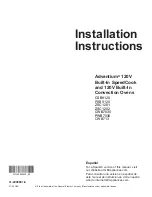
Technical Support US: 888-443-2751
Technical Support INTL: 316-943-2751
38
OVEN TROUBLESHOOTING
Proper Cooking
Experimentation is about the only way to determine proper time and temperature settings.
While a pizza may look perfectly cooked on the outside, the inside may be undercooked. A ther-
mometer is necessary to determine if food items are being properly cooked. Most health depart-
ments have rules and regulations that establish minimum temperatures for internal food tempera-
tures. Most operators want to cook foods as fast as possible in order to serve more customers per
hour. However, cooking foods slower is the only way to achieve a proper internal temperature. If
your food products look acceptable on the outside, but have an internal temperature that is too low,
then lowering the temperature and decreasing the belt speed (thereby increasing the cook time),
will be necessary.
Several factors may affect the cooking performance and characteristics:
Oven temperature (generally affects color)
Conveyor speed (generally affects doneness)
Finger arrangement
Altitude
Pans versus screens
Dough thickness
Cheese type
Raw ingredient temperature (frozen?)
Quantity of toppings
XLT ovens can be configured to cook a wide variety of food items. This is accomplished
by arranging the fingers to control the baking characteristics. Generally speaking, most cooking is
a “bottom up” process. The hot air from the bottom row of fingers has to go through the conveyor
(a distance of about 2” / 50.8mm), heat the pan or screen, and then actually cook raw dough. The
hot air from the top, on the other hand, basically only has to melt cheese and re-heat precooked
toppings. Consequently, most operators will use the oven with the fingers arranged so that a lot
more air is directed to the bottom of the pizza than to the top. There are places for an equal num-
ber of fingers above and below the conveyor. Available are finger cover plates that have six rows
of holes, four rows of holes, two rows of holes, and no holes (or blank cover plates). A typical fin-
ger arrangement might have most or even all fingers on the bottom “full open”, that is fingers with
all six rows of holes, and only two or three fingers on top with four or six rows of holes. The top
fingers can be arranged in a symmetrical pattern or can be shifted asymmetrically to either the en-
trance or exit end of the conveyor. We encourage you to experiment by trying different finger ar-
rangements, temperatures and belt speeds. XLT Ovens can assist you with your oven/product con-
figurations.
















































